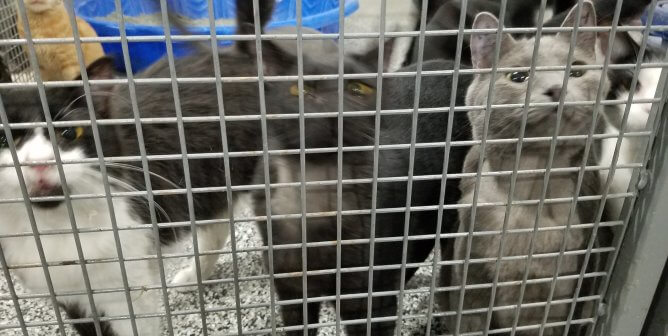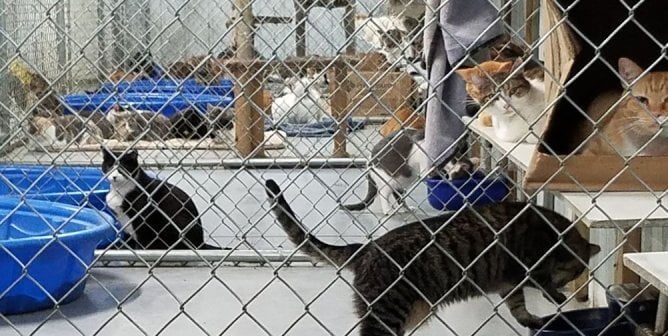Inside The Exotic Animal Trade
When people succumb to the temptation to purchase “exotic” animals such as hedgehogs, macaws, lizards, and monkeys—even tigers and bears—from stores, auctions, or the Internet in order to keep them as “pets,” it often leads to pain and death for these animals, who can easily suffer from malnutrition, loneliness, and the overwhelming stress of confinement to an unnatural and uncomfortable environment. The exotic animal trade is also deadly for animals we don’t see: For every animal who makes it to the store or the auction, countless others die along the way.
Animals Suffer During Capture and Transport
The journey for many of these animals begins in places like Australia, Africa, and the jungles of Brazil. The few laws and penalties that do exist hardly dissuade dealers in light of the money that can be made from smuggling: Prices on animals’ heads range from tens of thousands of dollars for a hyacinth macaw to a few bucks for a giant cockroach.1,2
When trappers take animals away from their natural habitats, the animals often change hands several times through intermediaries and exporters, and they endure grueling transport conditions. Parrots might have their beaks and feet taped and be stuffed into plastic tubes that can easily be hidden in luggage, and stolen bird and reptile eggs are concealed in special vests so that couriers can bypass X-ray machines at airports.3 Baby turtles have been taped so that they are trapped inside their shells and shoved by the dozen into tube socks, and infant pythons have been shipped in CD cases.4 In one case, a man who was arrested at the Los Angeles airport had Asian leopard cats in a backpack, birds of paradise in additional luggage, and pygmy monkeys in his underwear.5 Their chances of survival? “We have a mortality of about 80 or 90 percent,” says a German customs agent.6
Exotic animals can suffer further at the hands of dealers who sell to pet stores and zoos. PETA’s undercover investigation of U.S. Global Exotics resulted in a raid of the dealer’s Arlington, Texas, warehouse and the seizure of more than 27,000 animals who had been subjected to crowded living conditions, poor ventilation, and a lack of food, water, and basic care. More than 400 iguanas (half of whom died) had been left in shipping crates for about two weeks without food or water because of a canceled order. Hundreds of dead animals were discovered during the raid, and more than 6,000 died afterward because they were too ill to be saved.7 For more on this investigation, please visit PETA.org.
Ignorance Breeds Misery
Animals who do survive long enough to be sold are often subject to inadequate care. Because caretakers are often unprepared or unable to provide for the needs of animals who are so far removed from their natural habitats, many exotic animals will likely die or be abandoned by their caretakers. For instance, the head of South Africa’s Western Cape Environmental Crime Investigation unit estimates that 90 percent of exported reptiles die within a year.8 Hedgehogs, who roll themselves into tight balls, can easily become injured if children try to “uncurl” them or if cats attack them. Sugar gliders are very social animals, and if they are not given enough attention, they may mutilate themselves or die from the stress of loneliness.9
The American Zoo and Aquarium Association says that “zoos are being asked by irresponsible owners to relocate displaced and unwanted animals … [but] because most zoos do not accept donations—there are literally thousands of exotic animals [who] remain in unsuitable conditions.”10 Some people sneak animals into exhibits—and risk infecting zoo populations with diseases—or leave animals in front of zoo gates; these animals are usually euthanized. John Linehan, president of the Franklin Park Zoo in Boston, laments, “[I]n most cases, we can’t find appropriate places for animals dumped on us. If people would stop buying animals illegally and animals they simply cannot take care of, it would save a lot of misery for a lot of animals.”11
Other people simply turn unwanted animals loose or abandon them along rural roads. Without appropriate habitats or rehabilitation, many of these animals will starve or fall victim to the elements or predators. Those who do survive may overpopulate and wreak havoc on the ecosystem, killing native species. For example, Burmese pythons kept as pets have escaped and been released into the Everglades, where they have since flourished in the wild and threaten endangered birds and native snakes.12
Disease Threat
The U.S. Centers for Disease Control and Prevention (CDC) handles the importation of animals—specifically cats, dogs, turtles, birds, bats, civets, African rodents, and nonhuman primates—that may pose a disease threat to humans.13 Unfortunately, according to one CDC officer, “[T]here are all kinds of exotic species that may be unknown vectors of human disease.”14 Seventy-five percent of all new infectious diseases originate from nonhuman animals.15 The American Academy of Pediatrics cautions, “Most nontraditional pets pose a risk to the health of young children and their acquisition and ownership should be discouraged in households with young children.”16
The monkeypox outbreak that affected dozens of people in the Midwest in 2003 was traced to a Gambian rat from Africa; the animal had been housed with prairie dogs in an Illinois animal dealer’s shed.17 Prairie dogs also have been known to carry the plague and tularemia.18 The herpes B virus can be transferred from macaques to humans; the CDC warns that “this risk makes macaques unsuitable as pets.”19 Human contact with reptiles and other exotic animals accounts for 74,000 cases of salmonellosis each year.20 A study in Archives of Disease in Childhood reported that children infected with salmonella from contact with reptiles were more likely to develop serious bacterial diseases than children who contracted salmonella from other sources.21 Hedgehogs can transmit salmonella bacteria as well as viral and fungal diseases, and their sharp spines can cause skin infections.22,23
Parrots and other exotic birds can transfer potentially deadly pathogens such as psittacosis, salmonella, and even avian tuberculosis to humans.24 Exotic Newcastle disease (END), which devastated whole flocks of chickens and turkeys in the 1970s, was believed to have been brought to the U.S. from South American parrots who were smuggled in for the pet trade.25 An outbreak of END in Florida resulted in the deaths of 8,000 parrots in 1980.26 “We’re not trained to detect diseases,” says a U.S. Fish and Wildlife inspection officer.27
Reverse zoonosis, or the transfer of human diseases to animals, can be a threat as well. Mumps, tuberculosis, and hepatitis are only a few of the diseases that can be transferred from humans to other animals and then back to humans.28
Other Dangers
National Geographic reports that for every tiger or lion trapped in a zoo, “there may be as many as 10 privately owned.”29 “A 600-pound tiger will do what it wants, when it wants to,” says Tippi Hedren, a former actor who now runs a big-cat sanctuary in California. “You buy this cute creature at 8 weeks old. After six months, it’s torn your house apart and taken a good chunk out of you.”30 There have been dozens of captive big-cat attacks in recent years, including incidents in which a tiger mauled his guardian’s 3-year-old grandson, a lion killed several dogs and trapped a boy in his room, and a Bengal tiger tore off the arm of a 4-year-old boy.31
Wolf hybrids have also increased in popularity—it’s estimated that hundreds of thousands of them live in homes across the country—and since 1982 at least 85 people have been hurt and 19 killed by these offspring of wolves and domesticated dogs.32 One veterinarian and animal behaviorist says that “people who breed these animals and sell them as pets are playing Russian roulette. It’s a gross misrepresentation to sell these animals as pets.”33 The American Veterinary Medical Association “strongly opposes keeping as pets any wild canines crossbred with domestic animals.”34
Few Governmental Regulations
The multibillion-dollar business of buying and selling protected wildlife is one of the largest sources of criminal earnings, behind only arms smuggling and drug trafficking.35 National Geographic says, “[W]ildlife trafficking may very well be the world’s most profitable form of illegal trade, bar none.”36 The U.S. is the main destination for exotic and endangered wild animals.37 National, state, and local governments are passing laws that prohibit the capture and sale of certain species, but most of these regulations are poorly enforced and are designed to protect humans from disease rather than ensuring that animals are handled humanely.
It can be difficult to sort out what governmental regulations exist to control the influx of exotic animals into the U.S. Endangered species are supposed to be monitored by the U.S. Fish and Wildlife Service (FWS), but smugglers find ways around inspections. Protected species may be hidden among legal animals or dangerous species of animals so that officers are less likely to thoroughly hand-inspect shipments.38 The FWS also suffers from a lack of resources. For instance, only six inspectors are assigned to the port of Los Angeles, which includes seven airports and seaports, and has more wildlife moving in and out than any other port in the country.39 “We can’t cover everything,” said one of the inspectors. Another inspector added, “In some states we have no officers watching out for trade; in other states we may have just one officer. I doubt that any officer would disagree with me when I say we do not have enough officers to take on the job.”40
Penalties for violations of the Convention on International Trade in Endangered Species (CITES) are stipulated by individual countries, and the punishments range from short jail sentences to fines. “People simply pay [the fine] and continue to break the law,” according to one CITES representative.41 Also, CITES protection does not apply to exotic animals who are born in captivity.42
What You Can Do
Never buy exotic animals from dealers or pet shops. Animal shelters and rescue groups are filled with dogs and cats who need good homes. Support legislation that would make owning exotic animals illegal in your community and prohibit the interstate sale of exotic animals.
If you are concerned about the welfare of an exotic animal in your community, contact your local humane society. Sometimes animal control officials only conduct investigations after they receive complaints from neighbors.
References
1Kevin G. Hall, “Trafficking of Animals Becoming Big Business,” The Virginian-Pilot, 16 Aug. 2001.
2China Daily, “Feeling Lonely? Snuggle Up to a Pet Cockroach,” 20 May 2003.
3Hall.
4Panorama, “Animal Underworld,” narr. Tom Mangold, BBC, 25 Feb. 2001.
5Stefan Lovgren, “Wildlife Smuggling Boom Plaguing L.A., Authorities Say,” National Geographic News, 26 July 2007.
6Panorama.
7Susan Schrock, “27,000 Exotic Animals Seized in Arlington Raid Shouldn’t Be Returned, Judge Rules,” Star-Telegram, 5 Jan. 2010.
8Business Day, “South Africa; Wily Smugglers Give Mother Nature a Raw Deal,” Africa News, 28 Jan. 2004.
9Christina Mehra, “Going Sweet on Sugar Gliders,” VetCentric, 11 Jan. 2001.
10Vicki L. Duckett, “Call of the Wild,” Communiqué, May 2001: 40.
11Megan Tench, “Animals at the Gate,” The Boston Globe, 30 June 2006.
12Adriana Brasileiro, “Florida Wants To Stop These Reptiles from Becoming The Next Python. Breeders Call It Overreach,” Miami Herald, 22 Feb. 2021.
13U.S. Centers for Disease Control and Prevention, “Bringing an Animal Into the United States,” 3 Nov. 2020.
14Frank D. Roylance and Michael Stroh, “Weak Regulation Allows Import of Exotic Animals,” The Baltimore Sun, 11 June 2003.
15Texas Veterinary Medical Association, “World Zoonoses Day: Most Emerging Infectious Diseases Originate in Animals,” Infection Control Today, 7 July 2018.
16Larry K. Pickering et al., “Exposure to Nontraditional Pets at Home and to Animals in Public Settings: Risks to Children,” Pediatrics 122(2008): 876-86.
17Jodi Wilgoren, “Monkeypox Casts Light on Rule Gap for Exotic Pets,” The New York Times, 10 June 2003.
18Roylance and Stroh.
19Stephanie R. Ostrowski et al., “B-Virus From Pet Macaque Monkeys: An Emerging Threat in the United States?” Emerging Infectious Diseases 4 (1998): 117-21.
20U.S. Centers for Disease Control and Prevention, “Is a Turtle the Right Pet for Your Family?” 31 May 2010.
21“Pet Reptiles Linked To Serious Infections in Children,” The Wall Street Journal, 15 Apr. 2015.
22Patricia Riley and Bruno Chomel, “Hedgehog Zoonoses,” Emerging Infectious Diseases 1(2005): 1-5.
23Pickering et al.
24Jacqueline P. Jacob et al., “Avian Diseases Transmissible to Humans,” University of Florida IFAS Extension, June 2003.
25California Department of Food and Agriculture, “Exotic Newcastle’s Disease,” Animal Health and Food Safety Services Fact Sheet No. 7, Oct. 2002.
26H.L. Shivaprasad, “Exotic Newcastle Disease in Caged (Exotic) Birds,” California END Task Force Oct. 2002.
27Roylance and Stroh.
28Los Angeles County Department of Public Health, Veterinary Public Health, “Overview of Zoonoses,” LAPublicHealth.org, 6 Sep. 2006.
29Bryan Christy, “The Kingpin,” National Geographic, Jan. 2010.
30Tom Vanden Brook, “Exotic Pets Growing More Accessible in USA; So Is Concern to Protect Humans as Well as Beasts,” USA Today, 6 Dec. 2002.
31Erin Kelly, “Attacks on Humans by Wildcats Kept as Pets,” Gannett News Service, 30 Nov. 2002.
32Dan Nephin, “Fatal Mauling Shows Dangers of Wolf-Dog Hybrids,” Associated Press, 5 Aug. 2006.
33“Dog Attack Deaths and Maimings, U.S. & Canada, September 1982 to December 31, 2014,”DogsBite.org, accessed 16 Apr. 2015
34American Veterinary Medical Association, “Hybrids of Wild and Domestic Animal Species,” Veterinary Biologics, Nov. 2009.
35Clifford Coonan, “Illegal Wildlife Trade Is Worth ₤6bn a Year,” The Independent, 23 Aug. 2006.
36Christy.
37Kris Axtman, “After Exotic Pets Are Rescued, What Next?” The Christian Science Monitor, 26 July 2006.
38Michael Blood, “Critter Crackdown Has No Bite,” New York Daily News, 23 June 2003.
39Rachel Nuwer, “Many Exotic Pets Suffer or Die in Transit, and Beyond—and The U.S. Government Is Failing to Act,” National Geographic 2 March 2021.
40Bryan Robinson, “U.S. Smugglers Hot for Exotic Animal Parts,” ABC News, 26 Feb. 2010.
41Nancy Imperiale, “Monkeypox Gives Wake-Up Call About Exotic Pets Brought Into Country,” Orlando Sentinel, 1 July 2003.
42Brian Handwerk, “Big Cats Kept as Pets Across U.S., Despite Risk,” National Geographic News, 9 Oct. 2003.







